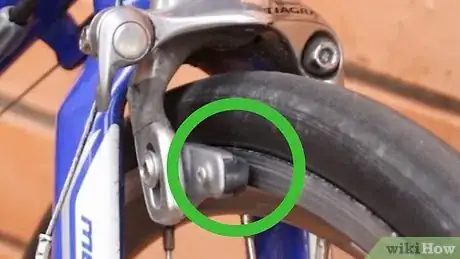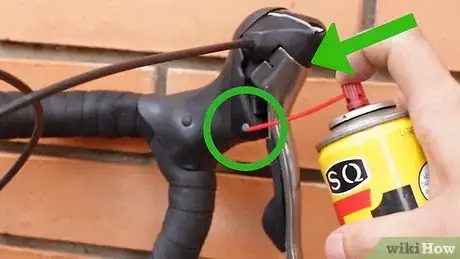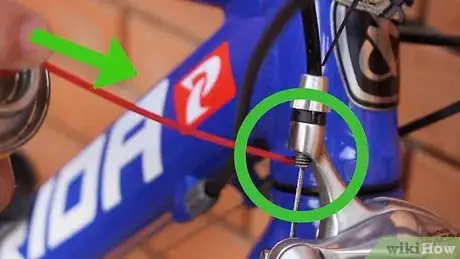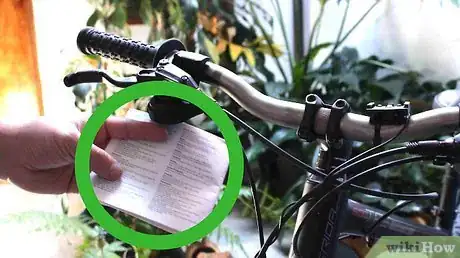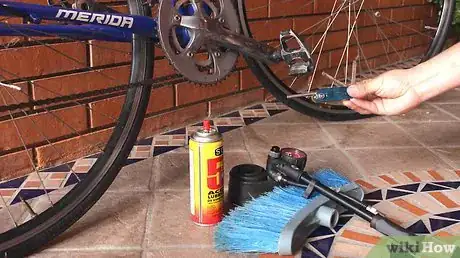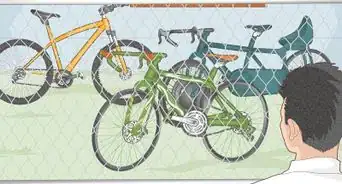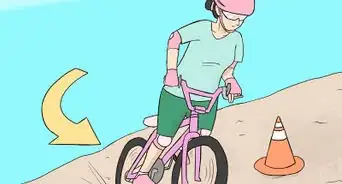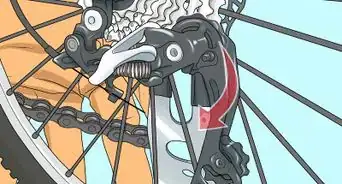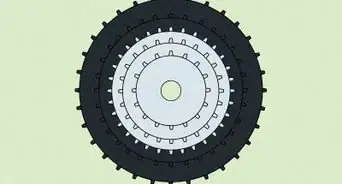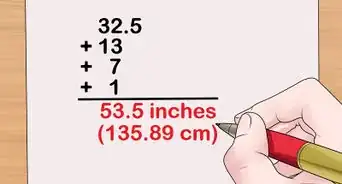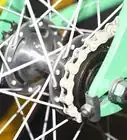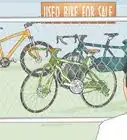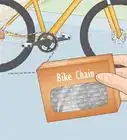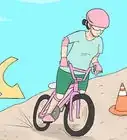This article was co-authored by Ikaika Cox. Ikaika Cox is the Shop Director at the Salt Lake City branch Bicycle Collective in Salt Lake City, Utah. He has been a bike mechanic since 2012, beginning as a volunteer with the Provo Bicycle Collective, and growing and honing his skills as a bicycle mechanic and educator in multiple Bicycle Collective locations over the years. He now leads the Salt Lake City branch of the Bicycle Collective.
There are 9 references cited in this article, which can be found at the bottom of the page.
wikiHow marks an article as reader-approved once it receives enough positive feedback. In this case, 91% of readers who voted found the article helpful, earning it our reader-approved status.
This article has been viewed 506,725 times.
Are your bicycle brakes stuck, preventing you from riding? When brakes drag or stick, there are a few things you can try to fix them yourself. Checking the brake pads, lubricating the lever pivots and adjusting the cables are all easy to do on your own. If the damage is more serious, then you may need to visit a bicycle shop, or even replace your brake system.[1]
Steps
Trying Basic Fixes
-
1Make sure that the brake pads aren't worn down. Pads that are worn down significantly will stick no matter how much you adjust them. If your brake pads are less than 1⁄4 in (0.64 cm) thick, then you need to replace them. They should be "toed-in," meaning that front edge of the pads should touch the wheel rim first when you press the brake lightly.[2]
-
2Check for a lip on the brake pad. Some brake pads have a "lip" that sticks out on the side closest to the hub. This is caused by uneven wear and you will need to file or sand it down if there is a lip. If you've worn your pads down around the lip, then they might get stuck in the rim.[3]
- Sand or file down the lip. If you do find that the lip is sticking out too far, file or sand it down with sandpaper so that the wheel can spin smoothly. Be very careful not to sand off so much that the brake pads won't work! You may need to remove the wheel to do this.
Advertisement -
3Lubricate the lever pivots. These are the points upon which the individual parts of your breaks pivot. If your levers feel rigid, try oiling the "pivot" pins on the lever handle. Place a dab of oil on each pivot point. Use a light machine oil or a special bicycle lubricant for best results.[4] After you oil the lever pivots, they should feel snappy and quick when you pull them.
- Do not use lubricant on brake pads, rotors, or rims. This might ruin the pads and make it hard for you to stop your bike!
Adjusting the Cables
-
1Check the cables and replace them if needed. Look for split housing and corroded cables, and replace the housing and cables if needed. If your levers are fine and the pad isn't stuck to the wheel somehow, then your cables form the next likely problem area. You should be able to fix your cables by hand without consulting a mechanic.[5] If you do have trouble, however, don't hesitate to take your bicycle in to a shop.
- Split housing and corroded cables are common when you have stuck brakes.
-
2Adjust the cable lengths to increase tension. The cable length adjustment is perhaps the most basic brake repair task that you'll encounter. On a typical safety bike, you can make fine adjustments without any specialized tools. Simply turn a barrel adjuster to make the best fit at the end of a length of cable housing. The barrel adjuster for a V brake is normally located on the hand-lever, where the housing exits.[6]
-
3Lubricate the cables. Get lubricant in an aerosol can with a tube. Then, spray oil into the cable housing at the ferrule: the cap where the cable enters the housing underneath the brake levers.[7] Use a light machine oil with a small nozzle similar to "3 in 1" Oil, or purchase a special brake cable oil at a bike shop. Spray gently, and don't over-saturate the cables.
- WD-40 and other industrial-grade degreasing products may "wash" the factory lubricant off the cable. When the WD-40 evaporates, there will be very little lubricant residue on the cable.
-
4Remove the tubing. If the cable is still stiff, try taking it out of its plastic tubing. First, remove the clamp at either the caliper or brake lever. Then, pull the cable out the opposite end. If you remove the cable, use an aerosol solvent (or even WD-40) to flush any dirt or debris from the cable tube while the cable is out. Apply a light coat of lithium grease or machine oil to the cable. Finally, reinstall the cable if it is not damaged.
- Put the cables back into the casing. Thread the loose end of the cable through the clamp at the end where you removed it.
- Then, check the "free travel": the distance the brake lever can be squeezed before the brake contacts the wheel. Tighten the clamp when the brake pads are about 1⁄4 inch (0.6 cm) from the wheel with the lever released.
Using Advanced Fixes
-
1Bleed and replace the brake fluid. If possible, consult the manufacturer’s instructions and any video tutorials you can find to ensure that you get the correct type of bleed kit for your bike. This only applies to hydraulic brake systems. If you have hydraulic brakes, then the fluid will occasionally need to be bled and replaced.[8]
- Make sure you don't get a lot of air bubbles in your replacement fluid. This can lead to the brakes feeling soft.
- Never use mineral oil as brake fluid if your user's manual specifies DOT (Department of Transportation-approved brake fluid).Likewise, never use DOT if your manual tells you to use mineral oil.' If you mixed up your fluids last time you bled the system, then that might be your problem.
- Avoid getting any oil or dot fluid on the brake pads because this will ruin them.
-
2Consult your user's manual for more specific instructions. There are several kinds of hydraulic systems, and each is a little bit different. Look to your manual for step-by-step instructions. If you can't access your manual, try to figure out exactly what type of hydraulic system you have, and then find online instructions for that specific system. If you're still having trouble, then consider visiting a bike shop.
-
3Adjust the calipers for rim brakes. The calipers are the part of the bike that actually squeeze the brake pads to the tire on rim brakes. Here's how to adjust them:
- Unscrew the brake pads, located on the inside of the brake calipers above your tires. The brake pad is the small piece of rubber on the lower inside of the caliper that actually comes into contact with the wheel.[9]
- Adjust the brake so that it is 3 - 5 mm from the rim.
- Tighten the brake pad. Spin the wheel in the air and test the brakes. Adjust further as needed.[10]
-
4Take your bike to a mechanic. If all else fails, then it may be most efficient to ask a professional to fix your brakes. Look for a reputable bike shop or mechanic in your area.
- Read bicycle shop reviews online before you visit. You should be able to get a good sense for whether the mechanics there are helpful.
Community Q&A
-
QuestionI just bought a bike and brought it home in a car. It was fine when I took it out, but then I tried to bring it up a few stairs and somehow my brake got stuck and now the back wheel is jammed. What can I do?
 Community AnswerMake sure the cables are aligned and clamped down. If this doesn't work then check the wheel position and make sure it is not crooked.
Community AnswerMake sure the cables are aligned and clamped down. If this doesn't work then check the wheel position and make sure it is not crooked. -
QuestionHow do I loosen the brake when it is stuck to the wheel?
 Community AnswerGet some gloves, WD-40, and of course the bike. Spray the WD-40 and put on the gloves. Softly push and pull the parts apart. You may need a lot of WD-40.
Community AnswerGet some gloves, WD-40, and of course the bike. Spray the WD-40 and put on the gloves. Softly push and pull the parts apart. You may need a lot of WD-40. -
QuestionYesterday, I purchased a Huffy multi-speed comfort bike and put it in my truck. When I got it home, the front tire would not turn and I discovered that the brake pads were against the wheel and when I squeezed the front brake, it was tight. Is there any suggestion as to what I should do before taking it to a repair shop?
 Community AnswerTake it back to bicycle shop and ask them to fix it. If they won't fix it, ask if you could exchange it since you just bought it yesterday.
Community AnswerTake it back to bicycle shop and ask them to fix it. If they won't fix it, ask if you could exchange it since you just bought it yesterday.
Warnings
- Always remember to hook the brake back immediately after you re-install the wheel!⧼thumbs_response⧽
- Check your brakes before you go for any ride.⧼thumbs_response⧽
Things You'll Need
- Hex wrench
- Lubricant (optional)
- Brake fluid (optional)
- New brake pads (optional)
- Razor (optional)
References
- ↑ http://www.bikeforums.net/bicycle-mechanics/667638-front-break-gets-stuck.html
- ↑ http://www.bikewebsite.com/bicycle-bra.htm
- ↑ http://www.bikeforums.net/bicycle-mechanics/667638-front-break-gets-stuck.html
- ↑ http://www.bicycling.com/maintenance/bicycle-maintenance/where-use-bike-lubricant
- ↑ http://www.mrbike.com/ask%20brakestuck.php
- ↑ http://bicycles.stackexchange.com/questions/2737/how-do-i-stop-my-brake-from-sticking
- ↑ http://www.sheldonbrown.com/cables.html
- ↑ http://www.bicycling.com/maintenance/bicycle-maintenance/hydraulic-disc-brakes
- ↑ http://www.sheldonbrown.com/calipers.html
- ↑ http://www.bikewebsite.com/bicycle-bra.htm
- Videos provided by sweetsbench
About This Article
To fix your stuck bicycle brakes, check to see if your brake pads are less than 1/4 inch thick, which means they need replacing. Then, if you see a lip on one of the pads, which is caused by uneven wear and tear, sand it down to even up your pads before trying them again. Another solution is to apply machine oil to your lever pivots, which are the parts that pivot the brakes on when you pull the levers on your handlebars. If none of these options solve your braking problems, check your brake cables in case they’re eroded or broken. Make sure the cables are tense enough to brake, since loose cables will reduce your braking power. For tips on how to replace your bike’s brake fluid, keep reading!
